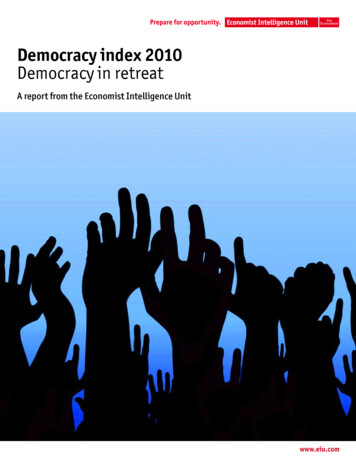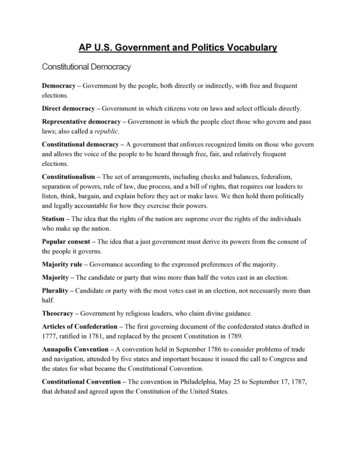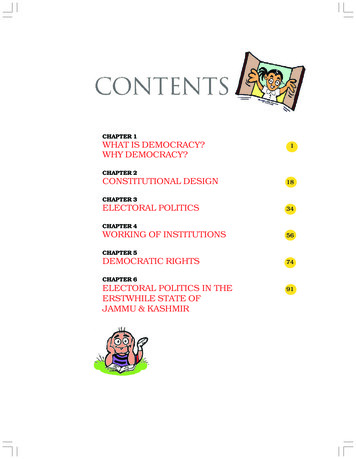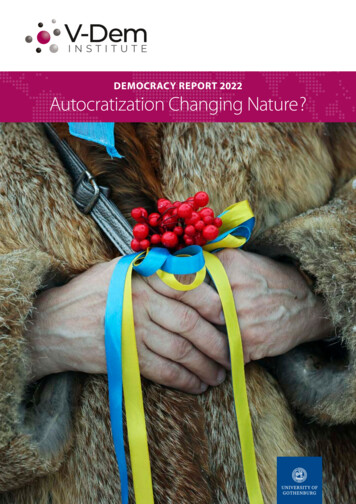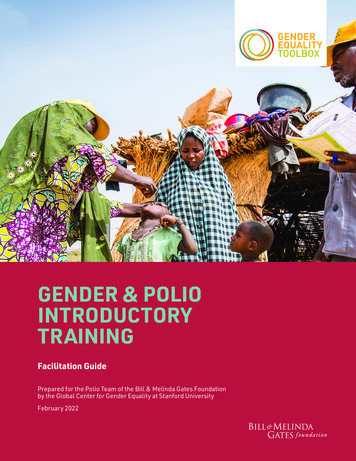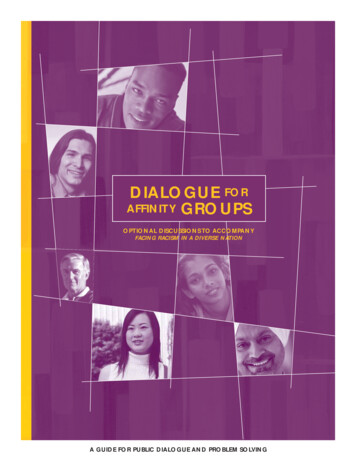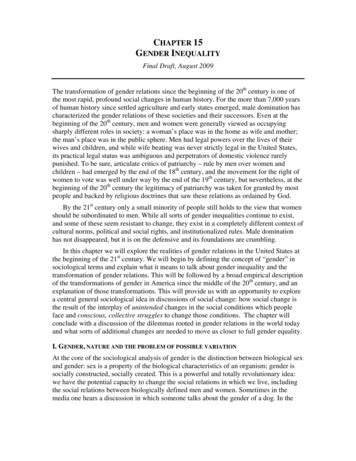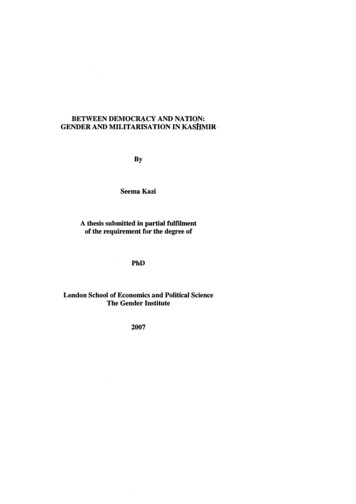
Transcription
BETWEEN DEMOCRACY AND NATION:GENDER AND MILITARISATION IN KASHMIRBySeema KaziA thesis submitted in partial fulfilmentof the requirement for the degree ofPhDLondon School of Economics and Political ScienceThe Gender Institute2007
UMI Number: U501665All rights reservedINFORMATION TO ALL USERSThe quality of this reproduction is dependent upon the quality of the copy submitted.In the unlikely event that the author did not send a complete manuscriptand there are missing pages, these will be noted. Also, if material had to be removed,a note will indicate the deletion.Dissertation PublishingUMI U501665Published by ProQuest LLC 2014. Copyright in the Dissertation held by the Author.Microform Edition ProQuest LLC.All rights reserved. This work is protected againstunauthorized copying under Title 17, United States Code.ProQuest LLC789 East Eisenhower ParkwayP.O. Box 1346Ann Arbor, Ml 48106-1346
AbstractThis thesis focuses on the militarisation of a secessionist movement involvingKashmiri militants and Indian military forces in the north Indian state of Jammu andKashmir. The term militarisation in this thesis connotes the militarised state and,more primarily, the growing influence of the military within the state that hasprofound implications for state and society. In contrast to conventional approachesthat distinguish between inter and intra-state military conflict, this thesis analysesIndia’s external and domestic crises of militarisation within a single analytic frameto argue that both dimensions are not mutually exclusive but have common politicalorigins. Kashmir, this thesis further argues, exemplifies the intersection betweenmilitarisation’s external and domestic dimensions. Focusing on the intersectionbetween both dimensions of militarisation in Kashmir, this thesis illustrates that thegreatest and most grievous price of using the military for domestic repression inKashmir and for military defence of Kashmir without (vis-a-vis Pakistan) is paid byKashmir’s citizens and society. Drawing on women’s subjective experience ofmilitarisation, this thesis highlights the intersection between state military processesat a ‘national’ level and social transformations at the local/ societal level. By way ofconclusion, this thesis argues that Kashmir’s humanitarian tragedy - exemplified byits gender dimensions - underlines why militarisation and and over Kashmir hasfailed to ensure ‘security’ for the state or security and justice for Kashmiri citizens. Adecentralised, democratic state with a plural concept of nation and identity, thisthesis suggests, is the best safeguard against use of the military for domesticrepression within and the extraordinary military and nuclear consolidation of theIndian state without.1
AcknowledgementsSincere and grateful thanks to Prof. Mary Kaldor and Prof. Anne Phillips atthe London School of Economics for their time, knowledge and support whilewriting this thesis. Grateful thanks to the Aga Khan Foundation, New Delhi, and toCatherine Hieronymi at AKF, Geneva. Grateful thanks also to Linda Johnstone,Rachel Trueblood and Ian Harriss and the International Peace Research Association,Colorado, for financial support during 2002-2004. Thanks to the LSE and the LSEGender Institute for their generous financial support over the years. I would also liketo acknowledge and thank the University of London’s Central Research Fund forfinancial support for field research conducted in Srinagar during March-April 2005.My deepest gratitude is to the people in Srinagar - both named and unnamed- who gave so generously of their time, knowledge, friendship and hospitalitythroughout my stay in Kashmir. Special thanks to the women (and men) Iinterviewed in Srinagar during 2004 - 2005 most of whom cannot be named yetwhose words are central to this thesis. Thank you for trusting me without knowingme.Grateful thanks to Parvez Imroz and Khurram Parvez of the Jammu andKashmir Coalition of Civil Society, Professor Bashir Ahmed Dabla and HameedaBano at the University of Kashmir, Tabassum Ishtiaq, Imtiaz Ahmed Khan, YasmeenRaja, Parveena Ahanger, Showkat Kathjoo, Feizal Mir, Sohail, Veena and Sunita, thePrincipal and teachers of Government College For Women, Srinagar. Grateful thanksalso to Yasin Malik and Tahir Ahmed Mir for their time and friendship in Srinagar.My thanks to the women in Kashmir and London who provided me a homeaway from home while writing this thesis. Thanks to Assabah Khan and GhulamFatima for their friendship and generous hospitality in Srinagar and to MoniqueDrummond for her warm friendship in London. Special thanks to Cynthia Cockbumfor her friendship, generosity and steady support while writing this thesis. Thanksalso to Marjan Lucas and Riet Turksma for their friendship and support. Finally, withlove and gratitude to my mother and family - thank you for your patience.2
TABLE OF CONTENTSAbstract1Acknowledgements2Table of Contents3Chapter 16Background, Limitations and Summary of ResearchMethodology12Representing Women: Empowering or Exclusionary?18Summary of Chapters25Chapter 237An Introduction to KashmirEarly History37Medieval Kashmir40Kashmir at Independence44Democracy in Kashmir: Promise and Betrayal48Chapter 354Militarism and MilitarisationMilitarism in the Modem World55Militarism in the Global South61Inside/Outside the Nation State in the Global South65A ‘State’ of Militarism68State against Nation69Militarisation73Militarisation and the Nation-State75Militarisation and Nation-State Building76War, Gender and the State783
Gender, Militarisation and the State83Chapter 488Militarisation and the Indian StateA Requiem for Non-Violence91The Giant and the Dwarf94A ‘State’ of Militarisation102Between Democracy and Nation107The 1990s: The ‘State’ of ‘The Nation’117Militarised Nuclear Nationalism: Inside/Outside the Nation-State125Concluding Remarks132Chapter 5134Militarisation in KashmirBetween Democracy and Nation in Kashmir137Kashmir: State of Fear and Fear of State149Judicial Paralysis159Inside/Outside the World’s Most Beautiful Prison163Ethnic Fragmentation165Violence and Counter ural Destruction175Civil Society1764
Chapter 6Gender and Militarisation in Kashmir182Azadi: A Popular Sentiment185A World of Widows192A Matter of ‘Honour’198The Cultural Politics of Militarisation209A Socio-Economic Crisis213A Psychological Crisis215The New Militancy217From Revolt to Jihad: The Struggle ss Corrupted222Concluding Remarks225Chapter 7228ConclusionIllusions of ‘Power’231Democracy, Militarisation and the Indian State235Gender, State and Militarisation239Re-imagining India by Re-Imagining Kashmir242Outside As Inside: Bridging the Inside/Outside Dichotomy248Bibliography251Appendix286Interviewee Details286United Nations Map of Jammu and Kashmir2885
Chapter 1Background, Limitations and Summary of ResearchThis research focuses on the militarisation of a secessionist movement involvingKashmiri militants and Indian military and paramilitary forces (hereafter referred toas the military) in the north Indian state of Jammu and Kashmir1 (hereafter referredto as Kashmir). Between 80,000 to 100,000 people have been killed in Kashmir sincethe beginning of the crisis in 1989-90. In the year 2007, the conflict entered itsseventeenth year with little hope towards cessation in the violence or human rightsabuse that characterises militarisation in Kashmir. The term militarisation in thisresearch connotes the crisis o f the militarised state and, more primarily, the growinginfluence of the military within the state that has profound implications for state andcitizen.The end of World War II and the decline of colonial powers led to theemergence of a number of new states in the Global South based on the model of theEuropean nation-state. This model centred on the concept of state security fromexternal threat that was assumed to be predominantly military in nature (Azar andMoon 1988a, 3). The idea of military security was based on a realist interpretation ofworld politics premised on the assumption that states exist in an ‘anarchic’ worldthat, in turn, demands the possession and consolidation of military force in order toresist or deter attacks from rival states. “Such logic dictates that each nation develop,maintain and exercise coercive. power.The capacity to coerce, kill, and destroybecomes the important source of power, and thus the pre-eminent safeguard fornational security” (1988a, 4).1 The conflict is situated in the Kashmir Valley in the north India state of Jammu and Kashmir. Theterm Kashmir here refers to the Valley, bound by the Jhelum River in the North to the town ofAnantnag in the southeast. The Valley o f Kashmir lies between the Himalayan Pir Panjal andKarakoram mountain ranges.6
A range of states in Global South (including India) replicated dominant ideasof military security to reinforce the global trend towards militarisation for externaldefence. Militarisation for external defence, as Keith Krause notes, is “systemic, inthe sense that it serves to reinforce militarisation at a systemic (international) levelwhere both “Northern and Southern states participate in [a] ‘global military order’”(Krause 1996, 174). Critiques of militarisation - particularly during the Cold Wardecades - focused on its (external) military-strategic dimensions to underline thedangers of states’ attempt to seek ‘security’ through military means. These analyseshighlighted the political and economic integration of new nation-states in the GlobalSouth within a Western-dominated global military-industrial order. While the demiseof the Cold War signalled the end of a super-power rivalry defined primarily inmilitary and nuclear terms, its implications for the Global South were not soprofound. As Paul Bracken notes “the Cold War shaped Europe much more than itdid Asia” (1999, xv). As Europe - “the locus of so many major wars” (Bracken1999, 2) - became more secure and cut back on its armed forces, a range of states inAsia (China, India, Iran, North Korea, Pakistan) embarked on military (and nuclear)programmes.In contrast to Western nation-states, military consolidation in the GlobalSouth was not driven exclusively by identifiable external (military) threats to the statebut by a range of non-military/political factors. While a modem, professionalmilitary was a symbol of state sovereignty in the Global South in the immediate post colonial period, this symbolism was subsequently overtaken by bombs and missilesas the new markers of modernity and nationhood. For instance, in Asia, Chinesetesting of nuclear weapon in 1964 was matched by India in 1974 (Bracken 1999, 91).Further, as Paul Bracken notes, the pursuit of weapons of mass destruction by statessuch as India derived from a convergence between nationalism and newly destructivetechnologies where “mass politicisation of military competition.creates anoverwhelming impulse to catch up, even if there is no catching up to do” (1999, 90).“Nationalism” in the Asian context, as Bracken argues “has made a second nuclearage” (1999, 93).7
As mentioned already, among the modem institutions adopted by newlyindependent states in the Global South was a professional military meant to defendthe state against external threat. The actual role of the military in a great number ofthese states, however, has not been restricted to that of external defence. On thecontrary, in many states across the Global South, the military is used to neutralisedomestic challenges to the state.While the nature of these challenges is diverse and historically contingent,what is of interest here is the negotiation of these challenges through military ratherthan institutional means - a trend that propels the military into an increasinglypolitical role within states in the Global South. States’ use of the military fordomestic repression unfolds in ways such that “the very fabric of social life is tom byviolence against civilians” (Kumar 2001, 7). In contrast to conventional, classic warwhere the military was subject to the laws of war designed to minimise directviolence against civilians, militarisation in the domestic context is neither subject tonor circumscribed by international law. The domestic variant of militarisationincludes not only direct violence against civilian by the military but also patterns ofgendered abuse such as rape - both of which constitute part of the methodology ofwar.Direct violence (by the military) against citizens opposed to the state including arbitrary detention, extra-judicial killing, torture, rape and sexual abuse “profoundlyaffect onsibilities of women and alter their relations with men during and afterconflict.’’(Kumar 2001, 7). In short, the domestic crisis of militarisation exerts adecisive and long-term influence on the societies within which it unfolds.While the acquisition of arms and weapons by states across the worldincluding the Global South constitutes an important and compelling area of analysis,the focus on militarisation’s systemic (global) dimensions is often at the cost of theunit (national/state) level of analysis. This point is particularly significant vis-a-visthe Global South where a pattern of extraordinary military consolidation - ostensibly8
for national defence - together with an increasing political influence (or dominance)of the military within is not so much a response to an imminent military threat to thestate but influenced by domestic political considerations. Indeed, ever since theiremergence, states in the Global South have witnessed wars that relate to stateformation and nation-building (Goor et al 1996a, 1).These wars, as just explained, involve the military yet represent a departurefrom the norms, rules and conduct of classic, conventional war. “In contrast to the‘classical’ inter-state wars which prevailed from the nineteenth until the earlytwentieth century, the various internal social conflicts now constitute thepredominant form of war” (Jung et al 1996, 57). As Donald Snow writes: “One of themost dramatic ways in which the post-Cold War world differs from the Cold Warinternational system is the pattern of violence that has been developing. Warfare inits most traditional sense has virtually disappeared from the scene.A different,darker pattern of violence has begun to emerge. .These wars. .seem. .less principledin political terms, less focused on the attainment of some political ideal” (1996, 1).They constitute what this study refers to as the domestic crisis of militarisation withinstates in the Global South that has explicitly political (non-military) origins.Militarisation, as Roland Simbulan notes:is the process of using the military .to suppress the people’s justdemands for a humane society. It logically connotes human rightsviolations by the physical presence or even saturation of soldiers .asituation which, to the general perception, implies and results incoercion.The main pretext of militarisation is the achievement ormaintenance of ‘political stability,’ national security,’ or othersimilar goals but whose real purpose is the maintenance of theregime in power (1988, 38).The term militarisation is used across the disciplines of InternationalRelations and Political Theory. Whereas in the former it is used with reference to theexternal military behaviour of states, in the latter it is employed in relation to the(domestic) institutional dimensions of state violence. Both are assumed to bemutually exclusive categories. This study however does not conform to thiscategorisation. The argument here is that military consolidation of the state (in the9
Global South) and the growing political influence of the military within it are inter linked processes. Accordingly, this research situates militarisation o f and in the statewithin a single frame of analysis.The case of India in this regard is particularly interesting. India’s initialrejection of the normative icons of militarisation i.e. nuclear weapons was influencedby the themes of Nehruvian internationalism and Gandhian non-violence (Cohen2001, 161). Paradoxically however, a state that achieved its independence bypeaceful means and committed itself to the principles of peace and disarmamentsubsequently appropriated the weapons of mass destruction it had rejected. Thistransformation, this study argues, is the outcome of constructions and imaginings ofthe ‘nation’ and ‘national ‘power’ that have a historical presence in Indian society(Roy 2003, 336).Further, the idea of a (militarily) powerful ‘nation’ in the Indian context isunderpinned by the construct of a centralised, unitary state and a “fictivehomogeneity.predicated on the belief that each unit of territory is ideally occupiedby a singular conception of the national citizen” (Krishna 1999, 231). This constructof state and nation is, in effect, a replication of the European model of the nation state that is at odds with India’s ethnic and cultural diversity. For precisely thisreason, “the quest to ‘secure’ the nation is premised practices that that generate themultiple insecurities that unravel the nation even as it is being made” (1999, 209).Kashmir exemplifies the intersection between militarisation for externaldefence and the use of the military for domestic repression that has transformed theIndian state into a source of deep insecurity for its citizens and converted the Indianmilitary into an illegitimate agent of repression. Both, in turn, seriously underminethe democratic credentials of the state. In contrast to conventional approaches, thisstudy illustrates militarisation in and over Kashmir as a complex, multi-dimensional,intersecting process: as a military impasse between the states of India and Pakistanwith nuclear overtones, as a war between Indian soldiers and Kashmiri militants, awar between the Indian soldiers and militants supported by the state of Pakistan and10
last, but by no means the least, as a war waged by the Indian state (i.e. the military)against Kashmir’s citizens.The primary focus of this study is Kashmir’s citizens and society and in thisrespect it constitutes a departure from conventional analyses. By focusing onKashmir’s civilian dimensions, this study illustrates a contemporary context wheremilitarisation includes yet also transcends its military-strategic and/or institutionaldimensions. In effect, this research highlights that state military processes are notseparate from but embedded within society. Militarisation in Kashmir - characterisedby military consolidation, nuclear nationalism, the use of the military as an agent ofdomestic repression, the dissolution of civil-military distinctions, the destruction ofcivil society and gender transformations - cannot therefore fit within andro and statemale-centric theoretical perspectives. Indeed, such frameworks “legitimate a way ofthinking about violence and conflict that.misses the dynamics associated with theactual experience of violence” (Nordstrom and Martin 1992, 4). This is not to denyor understate the importance of Kashmir’s institutional/ military-strategic dimensionsbut to emphasise their deep and enduring intersection with Kashmir’s society.By placing women’s subjective experience of militarisation at the centre ofthe analytic frame, this study highlights the intersection between state militaryprocesses at a ‘national’ level and gender transformations at a local/societal level. Incontrast to dominant approaches that attempt to fit empirical reality within aparticular theoretical framework, this study utilises women’s experience in Kashmirto inform and widen theoretical perspectives on militarisation. “Field reality aspresented here speaks simultaneously as context and theory. Interpersonal socialinteractions, state formations, and international power relationships are connected inthe field context in ways . [where] theory is drawn into the process of reflecting on‘the causes, significance and implications of experience” (Nordstrom and Martin1992, 5). To quote Nordstrom and Martin again, a gender analysis illustrates thatmilitarisation of and within the Indian state is “embedded in [political] and socialprocesses.and cultural realities of the population at large” (1992, 5). Finally, agender frame serves as a reminder that “the. task of the responsible intellectual11
[is]. to make sure that the binary frame narrative does not pre-determinearticulation of the experience (Cooke 1996,40).MethodologyResearch Location: SrinagarSrinagar is the capital of Kashmir. Apart from its importance as a capital city,Srinagar is an important historical, political, cultural and educational centre and ishome to press and media offices, major political parties and militant factions, non government and civil society organisations and the University of Kashmir. Srinagaris also an important centre for Kashmir’s Sufi traditions. The 1990 revolt centred onand was influenced by events in Srinagar.This research is not intended to be a representative study. By focusing on theexperiences of a small group of women (and a smaller number of men) in Srinagarduring the 1990s, this study illustrates the social and gender dimensions ofmilitarisation in Kashmir. While I do not claim this experience to be the only validexperience of militarisation, I use it to highlight the deep and enduring intersectionbetween militarisation in Kashmir and Kashmir’s citizens and society.Field research for this study was conducted during March - September 2004and March - April 2005 in Srinagar. Primary data includes a total of 31 interviews(see Appendix for details) including 23 interviews with Kashmiri women, two groupdiscussions with students and staff members of Government College For Women,Srinagar, four interviews with Kashmiri men and two interviews with officers of theIndian Army. My interviews with women and members of civil society were in-depthsemi-structured whereas interviews with officers of the Indian Army followed astructured format. All except two interviews were conducted in Urdu, in Urdu, mymother tongue. In both instances, simultaneous translation from the Kashmiri wasprovided by Tahir Ahmed Mir.12
Selection of Interviewees and other DetailsThe selection of interviewees was a considerably long-drawn process. It took sometime to get used to the pervasive and intrusive military presence and familiarisemyself with the centre and suburbs of Srinagar city. I had requested permission tostay on the campus of the University of Kashmir, Srinagar, but was informed by aprofessor who had forwarded my request to the Vice-Chancellor of the Universitythat the latter had objections regarding my research on ‘militarisation’. I thereforehad to seek private accommodation with a local friend that was facilitated andarranged by the Jammu and Kashmir Coalition for Civil Society (JKCCS).My daily interaction and voluntary work with JKCCS, visits to theDepartment of Sociology, University of Kashmir, the university library and meetingswith acquaintances and friends in the city introduced me to an initial group of maleand female interviewees. An initial selection of seven interviewees (six female andone male) and one group discussion was from this group. All female interviewees inthis group came from an upper/middle-class background while the lone maleinterviewee was a human rights activist from Delhi, working with the JKCCS. Initialinteraction with the interviewees was followed up by subsequent meetings at theirresidence during which I explained my own background, motivation for conductingthe research, a written undertaking to protect the identity of interviewees and explicitconsent for incorporating their words in my thesis. My interviews with members ofthis group which included teachers and students at the University of Kashmir,Srinagar’s Government College for Women, an ex-principal of the same college anda well-known female human rights activist-cum-academic at the University ofKashmir, were relatively easy after the initial introductory session. The interviewswere conducted during March - July 2004 and took place more or less on schedulewith little logistical difficulties.Having completed the first round of interviews which focused primarily onwomen from privileged backgrounds, it was subsequently easy for me to balance thisby focusing entirely on working class/underprivileged women in the second phase.The second, more intensive phase of interviews, focused on eight women fromunderprivileged/ poor backgrounds. This class, as mentioned in the study, has not13
only borne the brunt of militarisation but is more directly exposed to, and engagedwith, dealing with its daily realities. My visits to the office of the Jammu andKashmir Liberation Front (JKLF) and personal interaction with its president YasinMalik was helpful in facilitating interviews with working-class women. I waspersonally introduced to two interviewees from this group by a member of the JKLFwho also accompanied me for the interview and facilitated simultaneous translationfrom the Kashmiri into Urdu. Interviews with women from working-classbackgrounds were conducted in the areas of Batamaloo, Khanyar and Maisuma. Atthe same time, my association with the department of sociology and Prof. BashirAhmed Dabla at the University of Kashmir was valuable in gaining access to femalerespondents from socio-economically deprived backgrounds. Students from theUniversity accompanied me to Tengpora, a poor working-class suburb of Srinagar,where I conducted interviews with three women together with their family members.Interviews with poor women were a time-consuming process and involvedseveral logistical difficulties. Interviewees did not possess a telephone and thereforedates and timings for initial meetings and interviews had to be confirmed andreconfirmed by visiting the person’s residence several times. On several occasions,the interview had to be cancelled due to unforeseen circumstances of the intervieweeand fresh dates arranged involving the same process all over again.Against the anxieties and pressures generated by a military occupation andmy own identity as an Indian citizen which, in my opinion, could be conflated withthe Indian state, I expected a sceptical reception from Kashmiri respondents.However, instead of the anticipated reluctance from respondents to share personallife-experiences with an unknown (Indian) citizen, it was moving and humbling toencounter a sense of keen empathy and receptivity from respondents, for many ofwhom my Muslim identity was an assurance that I would understand and empathisewith the ordeal and suffering of Kashmiri Muslims. I was greatly moved by thegenerosity, hospitality and dignity of individuals and families who welcomed me intheir house without hostility or resentment, underlining the fact that Kashmiriresentment is centred against the Indian state and not its citizens. Whereas mygeneral experience with Kashmiri citizens was warm and cordial, an informaldiscussion with students in front of the University of Kashmir’s Allama Iqbal Library14
degenerated into unpleasant hostility on the issue of women’s rights. Students’ angerand resentment at the devastation wrought by Indian hegemony in Kashmir wasexpressed in Islamic terms. While appreciative of my sympathy for the suffering ofKashmir’s people, students could not countenance criticism of doctrinaire Islam. Theirony of being a (Muslim) woman and witness to crude hostility from Muslim men who were ostensibly struggling for democracy and democratic rights - for criticisingpatriarchal dominance was bitter. Among other epithets, I was branded anIndian/Hindu-US-Zionist agent, shouted down and threatened. Friends advised me tokeep away from the campus for a few days and not move around alone.The interviews with Yasmeen Raja of the women’s group Muslim Khwateene-Markaz, and Islamic activist Asiya Andrabi were facilitated by a local friend,introduced to me by the JKCCS. The interview with Asiya Andrabi was conducted ina safe-house in Khanyar. Both interviews were conducted on time and with relativeease.The interview with members of the military could not be conducted in 2004due to a lack of time and also because it is not possible to interview individualsoldiers without official permission from the authorities. I returned in 2005 with therequired documentation to gain permission to interview military officers. Takingpermission from the military authorities in Badami Bagh cantonment (Kashmir’sGuantanamo) was time consuming and was finally granted after two visits. I wasallowed to interview the Public Relations Officer (PRO) at Badami Bagh. I took thisopportunity to conduct an informal interview with a Colonel of the Indian army whosigned my entry papers and shared his views on the situation in Kashmir oncondition of strict anonymity. Notwithstanding the testimonies of human sufferingand indignity, my visit to the military headquarters was the most depressing andharrowing of all my experiences in Kashmir. I went to Badami Bagh in my capacityas an Indian citizen, wishing to ask for an explanation for Kashmir’s tragedy inflictedlargely by members of a vital institution of the Indian state. My questions were metwith stone-walling and a persistent refusal to admit to any wrong doing by themilitary - exemplifying the complete absence of public accountability in Kashmir2 Informal discussion with students at the University of Kashmir, Hazratbal, Srinagar. 13 June 2004.15
Nature. Length and Transcription of InterviewsAll individual interviews were long, semi-structured interviews. Whereas theinterviews in the first phase were completed in a single sitting, this was not the casewith the second round. This was primarily due to logistical reasons mentioned aboveas well as my own decision, in some cases, to defer the interview b
Gender Institute for their generous financial support over the years. I would also like . knowledge, friendship and hospitality throughout my stay in Kashmir. Special thanks to the women (and men) I interviewed in Srinagar during 2004 - 2005 most of whom cannot be named yet . South within a Western-dominated global military-industrial order .

